| Volume
95
Altata
May 2003
Less than a week after
the 2Cs returned to Mazatlán from
our adventures in the Virgin Islands, we were off the dock and
sailing north to Altata. In truth the boat probably wasn’t
quite ready to be underway, but WE sure were.
Altata is one of those
special places that is off the beaten path. It appears on the
charts as a small village at the north end of
a huge lagoon about 100nm north of Mazatlán. There are several
such lagoons along the mainland coast between Mazatlán and
Topolobampo, but none of them appears in any of the cruising guides
we have on board. Indeed, but for one entry in one guidebook for
the large commercial port of Topolobamo, the whole 375 miles of
coast between Mazatlán and Guaymas/San Carlos might not
exist.
The instructions to find Altata are passed on from boat to boat
in an ever-expanding set of Xerox pages. The first visitor, a catamaran
called Spindrift, came sometime in 2001, and they wrote up a brief
article for Latitude 38, a West Coast based sailing magazine. In
April 2002, four boats ventured in, one of whom, Perpetua, assembled
a detailed list of 18 annotated waypoints to get boats safely in
from outside the outermost channel marker right up to the anchorage
in front of Altata.
In late May, 2003, southerly
winds brought three boats – Lady
Galadriel, Camira and Tackless II – to the outer waypoint
shortly after daybreak and at just about high slack tide. In theory,
ideal timing. It was reassuring to see an actual buoy marker right
where it was supposed to be, but it was less reassuring to see
the huge breakers crashing on the fringing bars! We knew the waypoint
string had been used successfully by the several dozen boats that
had been here before us over the past couple of years, but we wondered
if we might be the first boats to come in southerly conditions.
No matter how you slice it, a string of waypoints through an entrance
like this is purely an act of faith. Still, we’d come all
the way here…and there were some buoys. We decided to give
it a shot.
After one false start,
T2 ended up leading the way. Not because we were braver, but,
because our cockpit sits higher, we could
see the buoy farther in! Once started there was no changing our
mind, and we literally surfed in over the bar, wrestling with the
helm to keep the boat from turning broadside as she rode several
huge rollers. And then it was calm. Whew! We looked around behind
us to check on our buddies and there was Lady Galadriel, but Camira’s
mast was headed the other way. It was the price they paid, they
said, for being the last in line and watching the show!
 The rest of
the waypoints led us along a deep-water channel seventeen miles
through the
estuary nearly to the north end where Altata
sprawls along the inner shoreline. Altata is a fishing village
gone tourist. But unlike so much of Mexico that we see, the tourists
that Altata caters to
are locals from nearby Culiacan, not gringos from the North. A
long string of about thirty palapas and restaurants front the beach,
so close, in fact, that when the tide rises the chairs and tables
are standing in the water, and waiters are said take care of patrons
wearing galoshes!. Behind the beachfront is a village two blocks
deep with streets of sand, a couple of tiendas and bakeries, a
busy schoolyard plus a bunch of homes that are just a hair nicer
than one might expect to see. Strung along the beaches to the north
and south of town are relatively upscale vacations houses, most
of which are empty except for holidays like Semana Santa.. The rest of
the waypoints led us along a deep-water channel seventeen miles
through the
estuary nearly to the north end where Altata
sprawls along the inner shoreline. Altata is a fishing village
gone tourist. But unlike so much of Mexico that we see, the tourists
that Altata caters to
are locals from nearby Culiacan, not gringos from the North. A
long string of about thirty palapas and restaurants front the beach,
so close, in fact, that when the tide rises the chairs and tables
are standing in the water, and waiters are said take care of patrons
wearing galoshes!. Behind the beachfront is a village two blocks
deep with streets of sand, a couple of tiendas and bakeries, a
busy schoolyard plus a bunch of homes that are just a hair nicer
than one might expect to see. Strung along the beaches to the north
and south of town are relatively upscale vacations houses, most
of which are empty except for holidays like Semana Santa..
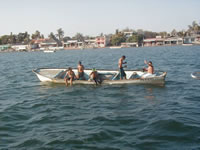 What makes Altata worth
the effort of getting to it is the simple fact that it is a happy,
welcoming place. Even during the slow
days of a late spring week, everybody seemed busy and no one let
us pass without a wave and a “buenas dias.” The palapas were set up with piles of shellfish to entice the passerby, and
several ranchero bands strolled the strip. Our very first day,
one band rode around the anchorage in a panga, whether for our
benefit or not we weren’t sure! Later they appeared to serenade
an afternoon party of office workers from Culiacan at La Perla.
Free divers with innertubes for their catch dotted the waters around
our anchored boats scouring the bottom for clams and cayos (what
we know as pen scallops). Whenever they caught us looking, we would
get a wave. And every evening a panga load of boys would paddle
out and anchor for an hour’s swimming practice, doing back
flips from the gunnels with tireless energy, practicing their surface
dives and doing some distance tests across the gap to Tackless…a
gap that got smaller every evening! What makes Altata worth
the effort of getting to it is the simple fact that it is a happy,
welcoming place. Even during the slow
days of a late spring week, everybody seemed busy and no one let
us pass without a wave and a “buenas dias.” The palapas were set up with piles of shellfish to entice the passerby, and
several ranchero bands strolled the strip. Our very first day,
one band rode around the anchorage in a panga, whether for our
benefit or not we weren’t sure! Later they appeared to serenade
an afternoon party of office workers from Culiacan at La Perla.
Free divers with innertubes for their catch dotted the waters around
our anchored boats scouring the bottom for clams and cayos (what
we know as pen scallops). Whenever they caught us looking, we would
get a wave. And every evening a panga load of boys would paddle
out and anchor for an hour’s swimming practice, doing back
flips from the gunnels with tireless energy, practicing their surface
dives and doing some distance tests across the gap to Tackless…a
gap that got smaller every evening!
Altata actually has
its own Port Captain, a gentleman who would be a fine role model
for many others in the country. He called
us on the radio when we dropped the hook and graciously suggested
we come see him the next day after we’d had a chance to rest
up from our overnight trip. Although he spoke some English, he
was clearly pleased as punch that Lisa and I spoke passable Spanish.
When we finally met the next morning, Captain Rodriguez not only
made us feel like honored guests, but he made it very clear that
more yacht traffic would be welcome here. He pulled out all sorts
of charts and printouts basically mirroring the information we
had already gotten to get here, but also some brochures for a huge
new development going across the lagoon on the barrier peninsula.
The first few yachts
that came into Altata took the Capitania’s
Office so by surprise, that he didn’t even know what or how
to charge them. Tackless II and Lady Galadriel were the 24th and
25th yacht to visit, so not only were the proper procedures in
place, but the usual routine of having to pay our fees at the bank
was also instituted. The nearest Banamex, however, was 30 kilometers
away in the town of Navolato. Since there don’t appear to
any taxis in Altata, this would be a problem if it weren’t
for the nature of the people.
 Enter Gustavo. Gustavo
is the proprietor of the La Perla Restaurant. Our very first
evening, before we had been ashore, Gustavo came
out by panga to the boats with his whole family to welcome us as
he has for most all the yachts that have visited Altata. Since
it was his experience that few cruisers speak Spanish, and since
he like the rest of the townspeople speak virtually no English,
Gustavo had called his son Caesar, who peaks fluent English from
schooling in the States. Caesar, however, lives an hour away in
Culiacan, yet he drove all the way out after the workday to interpret!
We were duly welcomed and it was arranged that Gustavo would drive
us to Navolato the next day. This in itself turned into a mini-adventure
with Don and Dennis riding in plastic chairs in the back of the
pickup along with Gustavo’s seven year-old grandson, Ramon,
while Lisa and I exercised our espanol with Gustavo in
the cab. Great
until we had a blowout! However, the truck came to a graceful stop,
the tire was cheerfully changed, the spare pumped up at the nearest
air station and the trip resumed. When business was complete, we
all stopped for ice cream! This set the tone for our five days
in Altata. Needless to say we ate every midday meal at La Perla! Enter Gustavo. Gustavo
is the proprietor of the La Perla Restaurant. Our very first
evening, before we had been ashore, Gustavo came
out by panga to the boats with his whole family to welcome us as
he has for most all the yachts that have visited Altata. Since
it was his experience that few cruisers speak Spanish, and since
he like the rest of the townspeople speak virtually no English,
Gustavo had called his son Caesar, who peaks fluent English from
schooling in the States. Caesar, however, lives an hour away in
Culiacan, yet he drove all the way out after the workday to interpret!
We were duly welcomed and it was arranged that Gustavo would drive
us to Navolato the next day. This in itself turned into a mini-adventure
with Don and Dennis riding in plastic chairs in the back of the
pickup along with Gustavo’s seven year-old grandson, Ramon,
while Lisa and I exercised our espanol with Gustavo in
the cab. Great
until we had a blowout! However, the truck came to a graceful stop,
the tire was cheerfully changed, the spare pumped up at the nearest
air station and the trip resumed. When business was complete, we
all stopped for ice cream! This set the tone for our five days
in Altata. Needless to say we ate every midday meal at La Perla!
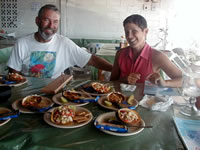 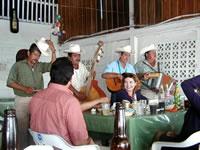 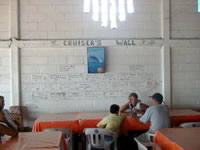
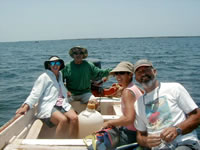 One
day Gustavo offered to show us the estuary, so we climbed into
his panga, along with
a 10 gallon jug of gasoline. We whizzed down the 17 miles to
the entrance in less than a quarter of the time we came up it,
were slightly reassured that the breakers looked smaller, and in
the southern half we turned inland up into the channel of the Rio
Culiacan. The river used to be fresh all the way down to the lagoon,
but dams upriver have allowed sea water to encroach almost all
the way up to Culiacan itself. Every area of the lagoon is rich
with shellfish -- probably a half dozen or more different kinds
of clams and oysters, and of course shrimp. In season (fall and
winter) the pangas hoist a sail and troll the shallow waters with
small-scale dredges, something that would be neat to see. Gustavo,
I think, is actually a fisherman at heart. He learned all the nooks
and crannies of the great the estuary from his father, and only
exchanged the boat for the restaurant when a brother died. One
day Gustavo offered to show us the estuary, so we climbed into
his panga, along with
a 10 gallon jug of gasoline. We whizzed down the 17 miles to
the entrance in less than a quarter of the time we came up it,
were slightly reassured that the breakers looked smaller, and in
the southern half we turned inland up into the channel of the Rio
Culiacan. The river used to be fresh all the way down to the lagoon,
but dams upriver have allowed sea water to encroach almost all
the way up to Culiacan itself. Every area of the lagoon is rich
with shellfish -- probably a half dozen or more different kinds
of clams and oysters, and of course shrimp. In season (fall and
winter) the pangas hoist a sail and troll the shallow waters with
small-scale dredges, something that would be neat to see. Gustavo,
I think, is actually a fisherman at heart. He learned all the nooks
and crannies of the great the estuary from his father, and only
exchanged the boat for the restaurant when a brother died.
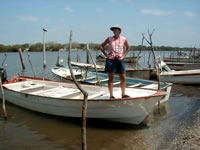 We got quite the object
lesson in the cost of fishing for these pangeros as we watched
the level of gasoline drop in Gustavo’s
jug! It really makes us wonder about all the pangas we see way
offshore. How do they afford it? We refilled our fuel bottle up
the Rio in the truly remote fishing village of Castillo, where
Gustavo was born. The town kind of reminded us of the San Blas
Islands, without even a glimmer of tourism. “Slips” for
dozens of pangas were staked out along the riverbank with sticks.
Fuel came not from
a Pemex station but was hand cranked out of a barrel at the local
fishing cooperative. Pelicans picked at fish guts on the shoreline.
People stared at us instead of waving. Although the uninhabited
stretches of the estuary looked enticing as remote anchorages,
Gustavo discouraged the idea, pointing out that in this part of
the bay there was “no authoridad.” Hmmm. We got quite the object
lesson in the cost of fishing for these pangeros as we watched
the level of gasoline drop in Gustavo’s
jug! It really makes us wonder about all the pangas we see way
offshore. How do they afford it? We refilled our fuel bottle up
the Rio in the truly remote fishing village of Castillo, where
Gustavo was born. The town kind of reminded us of the San Blas
Islands, without even a glimmer of tourism. “Slips” for
dozens of pangas were staked out along the riverbank with sticks.
Fuel came not from
a Pemex station but was hand cranked out of a barrel at the local
fishing cooperative. Pelicans picked at fish guts on the shoreline.
People stared at us instead of waving. Although the uninhabited
stretches of the estuary looked enticing as remote anchorages,
Gustavo discouraged the idea, pointing out that in this part of
the bay there was “no authoridad.” Hmmm.
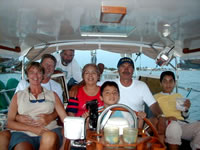 We left Altata before
the weekend crunch got going. We are told, on Sundays in particular,
it seems like all of Culiacan comes to
the beach! I think it would have been fun to see, but for sure
the nights wouldn’t have been so peaceful. Frankly, I think
the 2Cs could have stayed a lot longer. Gustavo’s natural
hospitality had bloomed into honest friendship by the time we weighed
anchor, plus he was an absolutely ideal conversation companion,
ready to whip out our dictionary at every sticking place in our
amazingly wide-ranging talks. We were pleased to host Gustavo,
his wife Lupita and the two grandsons out to the boats for wine, refrescos and
hors d’oeuvres, and they kept making special treats for us
in the restaurant, where we several times whiled away an afternoon
playing cards. We vowed to return in the fall. We left Altata before
the weekend crunch got going. We are told, on Sundays in particular,
it seems like all of Culiacan comes to
the beach! I think it would have been fun to see, but for sure
the nights wouldn’t have been so peaceful. Frankly, I think
the 2Cs could have stayed a lot longer. Gustavo’s natural
hospitality had bloomed into honest friendship by the time we weighed
anchor, plus he was an absolutely ideal conversation companion,
ready to whip out our dictionary at every sticking place in our
amazingly wide-ranging talks. We were pleased to host Gustavo,
his wife Lupita and the two grandsons out to the boats for wine, refrescos and
hors d’oeuvres, and they kept making special treats for us
in the restaurant, where we several times whiled away an afternoon
playing cards. We vowed to return in the fall.
Unfortunately, there
is a reason Altata is not a regular cruising stop and we were
faced with it again upon departure. That damned
entrance! We left when we did because the winds were forecast to
be northwesterly – absolutely the wrong winds for sailing
to Baja, but allegedly a better wind direction for getting over
the bar. Well, let’s just say conditions were not ideal.
As we backtracked our way along the waypoints to the bar, T2 suddenly
found herself driving into a breaking roller that seemed to rise
up from nowhere and stand a good four feet above the deck before
green water swept over the dinghy and into the cockpit. Two more
like the first followed, and then, as quick as they came up, we
were clear! Fortunately, we had prepared. The companionway was
closed, the hatches dogged down, all lose stuff was stowed, and
our harnesses on. Although we still had some water leak into the
salon, our chief slipup was not stashing our nice cushions below.
A thirty-hour beat with wet butts was a discouraging prospect.
However, a little fresh water and by afternoon the cushions were
dry again for our overnight slog to Baja.
I think we’ll still go back. I hope so. It was that special
a stop, with people we truly want to see again. However, I can’t
recommend to anyone going without a full understanding of what
they might encounter in the entrance.
|